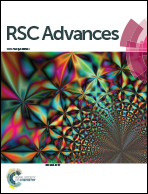Mn(ii)-Catalysed ortho-alkenylation of aromatic amines and its application in reproductive diseases†
Abstract
A Mn(II)-catalysed ortho-alkenylation of aromatic amines and its application in reproductive diseases were developed. The use of MnCl2 was critical for the ortho-alkenylation of aromatic amines. The general applicability of this procedure was highlighted by the synthesis of 27 vinylanilines, with good regioselectivities. The value of our approach in practical applications was investigated by studying the effects of one of the compounds 3m on 8 week-old adult male rats with azoospermia as a mammalian model. The results show that a small amount of sperm will gradually be produced in the epididymis and testes by treatment of 8 week-old adult male rats with azoospermia with 1 mg kg−1 3m after two weeks, while treatment with 10 mg kg−1 3m led to obvious sperm production. Notably, if we increase the dose to 100 mg kg−1, there will be a lot of sperm production in the epididymis and testes after two weeks of treatment. The results of this study will be of great significance in research on drugs for treating azoospermia and oligospermia diseases.



 Please wait while we load your content...
Please wait while we load your content...